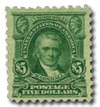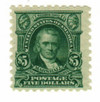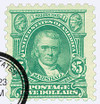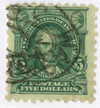
# 480 - 1916-17 $5 Marshall, light green
Series of 1916-17 $5 Marshall
Printed by: Bureau of Engraving and Printing
Printing Method: Flat plate
Watermark: None
Perforation: 10
Color: Light green
Happy Birthday, John Marshall
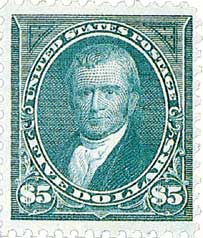
America’s longest-serving chief justice of the Supreme Court, John Marshall, was born on September 24, 1755, in Germantown, Virginia.
The eldest of fifteen children, Marshall only had one year of formal education as a child (during which time he befriended future president James Monroe). Despite this, his parents encouraged his love of reading, and he read widely to educate himself.
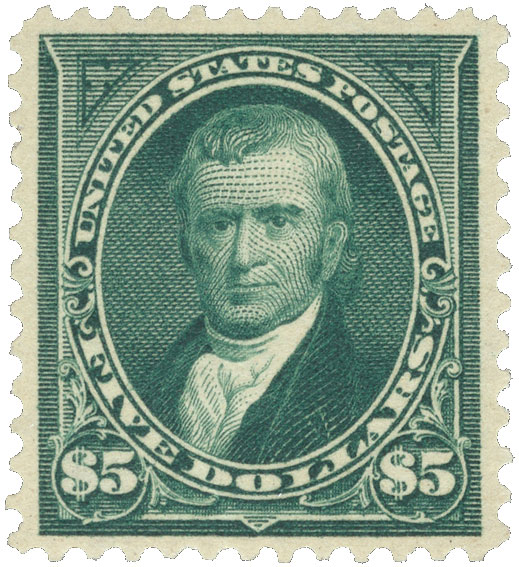
Following the Battles of Lexington and Concord in 1775, Marshall joined the Continental Army. He spent the winter of 1777-78 at Valley Forge with General George Washington’s forces. He was promoted to captain in 1778. Although he had little formal education, Marshall studied law at the College of William and Mary and was admitted to the Virginia bar in 1780. He quickly established a career defending individuals against their pre-Revolutionary War, British debtors.
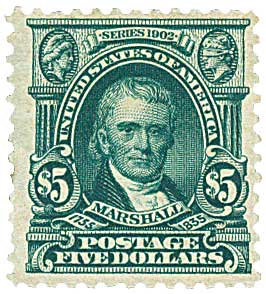
Marshall served several terms of office in Virginia’s House of Delegates. As a delegate to the constitutional convention, Marshall spoke forcefully in favor of a new constitution to replace the weak Articles of Confederation. After declining several positions in the Washington and Adams administrations, Marshall served briefly in the US House of Representatives.
In 1797, President Adams appointed Marshall to a delegation to France. The diplomatic negotiations were halted when the representatives refused to pay a bribe to the French. This became known as the XYZ Affair. The delegation left in April 1798. The following year, Adams appointed Marshall to be his secretary of State. He took office in June 1800. In this position Marshall negotiated the end to the Quasi-War, which was the result of the XYZ Affair. The arrangement brought peace between the US and France.
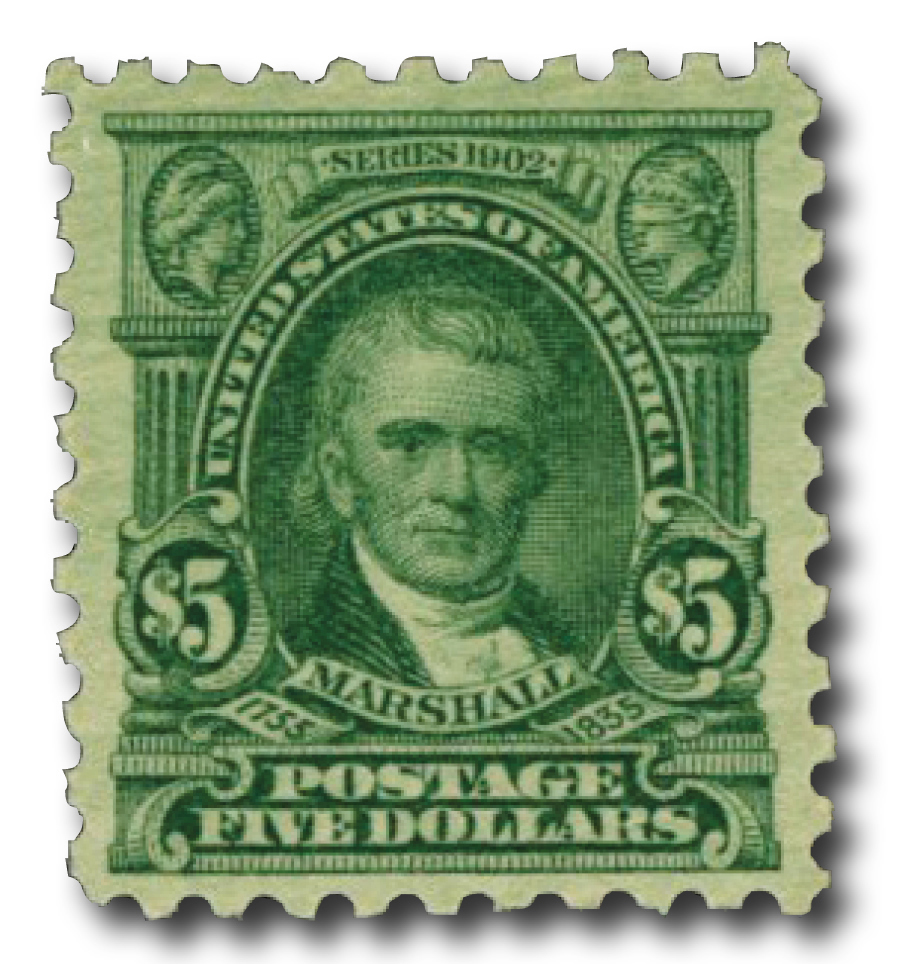
Marshall was appointed chief justice of the Supreme Court in 1800. The Senate confirmed his appointment on January 27, 1801, and he was sworn in on January 31, officially taking office on February 4. Marshall continued to serve as secretary of State as well until Adams’ term was completed one month later.
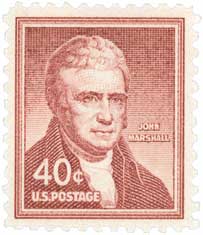
Marshall understood that the Constitution was the supreme law of the land, as is stated in Article VI. As such, any law enacted by a branch of government must adhere to its principles or be struck down as unconstitutional. The Supreme Court’s landmark decision in Marbury vs. Madison, which determined that an action by a public official violated another’s constitutional rights, reflected this concept of judicial review. Judicial review, which is the practice of reviewing actions of government branches, firmly established the Supreme Court’s powers.
As chief justice of the US Supreme Court for 34 years, Marshall participated in more than 1,000 decisions and authored more than 500 opinions. The legacy of the Marshall Court was an increase in the power of the Supreme Court as a branch of the federal government. It placed an emphasis on the role of the judiciary.

As a close friend of George Washington, Marshall announced Washington’s death in 1799, offered the eulogy at his funeral, and led the commission that planned the Washington Monument. At the request of Washington’s family, Marshall wrote a five-volume biography about our nation’s first president, The Life of George Washington. John Marshall died in 1835, ending the longest tenure of any chief justice in Supreme Court history.
Series of 1916-17 $5 Marshall
Printed by: Bureau of Engraving and Printing
Printing Method: Flat plate
Watermark: None
Perforation: 10
Color: Light green
Happy Birthday, John Marshall

America’s longest-serving chief justice of the Supreme Court, John Marshall, was born on September 24, 1755, in Germantown, Virginia.
The eldest of fifteen children, Marshall only had one year of formal education as a child (during which time he befriended future president James Monroe). Despite this, his parents encouraged his love of reading, and he read widely to educate himself.

Following the Battles of Lexington and Concord in 1775, Marshall joined the Continental Army. He spent the winter of 1777-78 at Valley Forge with General George Washington’s forces. He was promoted to captain in 1778. Although he had little formal education, Marshall studied law at the College of William and Mary and was admitted to the Virginia bar in 1780. He quickly established a career defending individuals against their pre-Revolutionary War, British debtors.

Marshall served several terms of office in Virginia’s House of Delegates. As a delegate to the constitutional convention, Marshall spoke forcefully in favor of a new constitution to replace the weak Articles of Confederation. After declining several positions in the Washington and Adams administrations, Marshall served briefly in the US House of Representatives.
In 1797, President Adams appointed Marshall to a delegation to France. The diplomatic negotiations were halted when the representatives refused to pay a bribe to the French. This became known as the XYZ Affair. The delegation left in April 1798. The following year, Adams appointed Marshall to be his secretary of State. He took office in June 1800. In this position Marshall negotiated the end to the Quasi-War, which was the result of the XYZ Affair. The arrangement brought peace between the US and France.

Marshall was appointed chief justice of the Supreme Court in 1800. The Senate confirmed his appointment on January 27, 1801, and he was sworn in on January 31, officially taking office on February 4. Marshall continued to serve as secretary of State as well until Adams’ term was completed one month later.

Marshall understood that the Constitution was the supreme law of the land, as is stated in Article VI. As such, any law enacted by a branch of government must adhere to its principles or be struck down as unconstitutional. The Supreme Court’s landmark decision in Marbury vs. Madison, which determined that an action by a public official violated another’s constitutional rights, reflected this concept of judicial review. Judicial review, which is the practice of reviewing actions of government branches, firmly established the Supreme Court’s powers.
As chief justice of the US Supreme Court for 34 years, Marshall participated in more than 1,000 decisions and authored more than 500 opinions. The legacy of the Marshall Court was an increase in the power of the Supreme Court as a branch of the federal government. It placed an emphasis on the role of the judiciary.

As a close friend of George Washington, Marshall announced Washington’s death in 1799, offered the eulogy at his funeral, and led the commission that planned the Washington Monument. At the request of Washington’s family, Marshall wrote a five-volume biography about our nation’s first president, The Life of George Washington. John Marshall died in 1835, ending the longest tenure of any chief justice in Supreme Court history.



